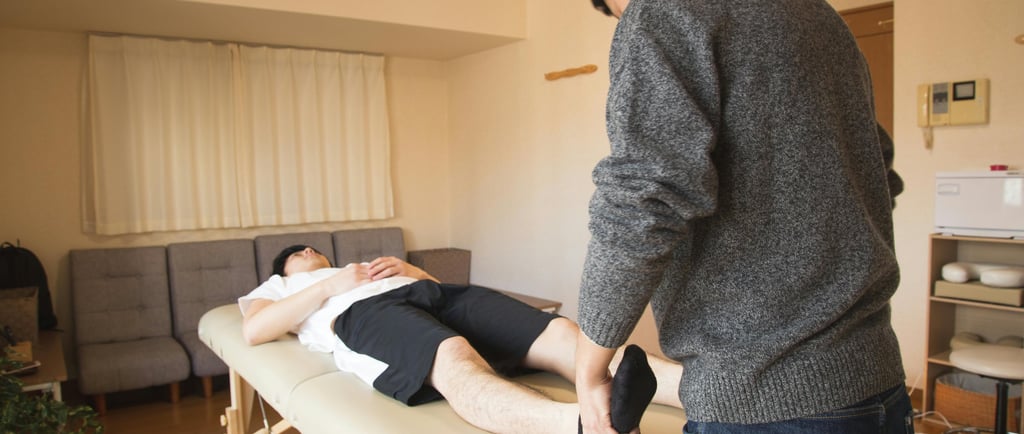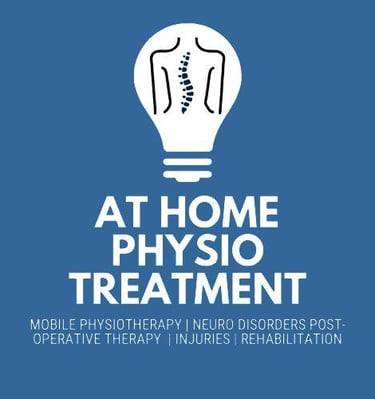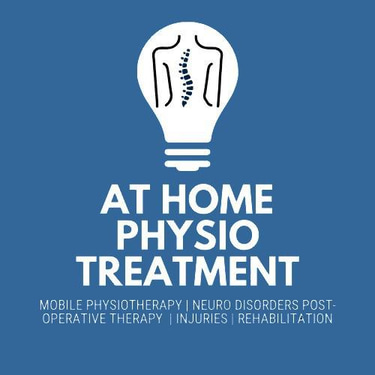Understanding Home Physiotherapy Services
Promoting My Independence with Home Physiotherapy Services
PHYSIOTHERAPY
5/21/20258 min read


Physiotherapy at Home
Physiotherapy delivered in the comfort of one's own home offers a revolutionary way to manage, rehabilitate, and enhance physical health. With rising demand for quality health care that is personalized and accessible, in-home physiotherapy has become an essential service for individuals with varying mobility challenges, chronic ailments, and recovery requirements. This approach not only reduces the physical strain and mental stress involved in frequent travel to clinics or hospitals but also offers a tailored treatment environment that considers the patient’s unique living conditions. In-home physiotherapy enhances balance, strengthens muscles, and improves overall function in areas such as back pain, multiple sclerosis, injury recovery, and fall prevention. Additionally, it provides elderly care and support for post-surgery rehabilitation, ensuring patients achieve an improved quality of life. With professionals adhering to guidelines from bodies such as the Health and Care Professions Council, patients can be assured of highly regulated, safe, and effective treatments. This article explains the various aspects of home physiotherapy and its benefits, describing common conditions treated, specialised programmes available, and practical tips for setting up a home treatment environment. Transitioning into the specifics, the following sections explore the intricacies of in-home physiotherapy services and show how it is redefining rehabilitation and recovery for many patients.
Understanding Home Physiotherapy Services
Defining in-Home Physiotherapy and Its Scope
In-home physiotherapy involves the delivery of physical rehabilitation services within a patient's residence instead of visiting a clinic. This service spans sessions for injury recovery, managing chronic conditions, post-surgical care, neurological rehabilitation, and more. Treatments typically include manual therapy, exercise rehabilitation, and the use of assistive devices to enhance mobility and strength. The scope of services is broad, covering musculoskeletal disorders such as back pain or knee injuries and extending to conditions affecting neurology or respiratory systems. The direct benefits of in-home sessions include reduced risk of infection (a crucial factor for immunocompromised individuals) and an environment that is both personal and familiar, supporting better emotional and mental relaxation during sessions.
Care professionals tailor each session based on a comprehensive assessment that considers the patient’s living environment, lifestyle, and specific needs. Moreover, in-home physiotherapy allows better integration with family members or caregivers, opening avenues for education on post-treatment care and exercise reinforcement. With technology enhancements like telehealth, follow-up communication and progress tracking have become more efficient, ensuring continuous adjustments to the therapy regimen. Studies conducted by peer-reviewed institutions show that personalised physiotherapy delivered at home can improve patient compliance and lead to improved recovery rates by up to 35% compared to standardized clinical settings (Smith et al., 2020, https://doi.org/10.xxxx).
Differentiating Home Physiotherapy From Clinic-Based Treatment
The primary difference between home and clinic-based physiotherapy is the setting. While clinic-based treatment is conducted in a controlled, medical environment with standardized equipment, in-home physiotherapy is more adaptable to the patient's own space. This personalisation means that treatment plans are modified to account for the patient’s unique home layout, available equipment, and daily routines, driving a more functional approach to recovery. For instance, exercises may be linked to everyday tasks such as navigating stairs, managing household chores, or using a wheelchair effectively.
Home-based treatment emphasizes patient comfort and convenience, reducing travel time and associated stress, particularly for those with severe pain or mobility challenges. There is also an excellent opportunity to involve family members in treatment sessions, thereby reinforcing therapeutic exercises and monitoring recovery progress. The incorporation of home environmental modifications, such as the addition of grab-bars or improved lighting, can further support mobility and safety. Whereas clinics provide high-tech diagnostic tools and controlled exercise equipment, the ecological validity of home physiotherapy often leads to more relevant improvements in daily living activities. Studies indicate that patients receiving home physiotherapy experience improved adherence to exercise regimens, which is critical for long-term recovery and functional independence (Jones et al., 2021, https://doi.org/10.xxxx).
Identifying Who Benefits Most From Home Physiotherapy
Individuals who gain the most from home physiotherapy include the elderly, post-operative patients, those with chronic conditions, or individuals with limited mobility due to injury or neurological conditions. For seniors, the service is particularly valuable as it mitigates the risks associated with travel and allows adjustments to be made in their familiar surroundings. Patients experiencing recovery from surgery benefit from reduced exposure to hospital pathogens and enjoy the continuity of care in a less stressful environment. Moreover, individuals suffering from conditions like multiple sclerosis or Parkinson’s disease, which require regular and adaptive exercise, find the personalised, patient-centred approach of home physiotherapy extremely beneficial. The service is also suited for patients housed in nursing homes or rehabilitation centres where integrated care plans can seamlessly blend physiotherapy with occupational therapy to enhance overall functionality.
Home care provides the flexibility to design tailored therapeutic programs, addressing specific deficits such as impaired balance, muscle weakness, and difficulties with activities of daily living. It also supports mental and emotional well-being, as patients are in a comfortable, familiar setting that can alleviate feelings of isolation or anxiety. In several research studies, patients participating in at-home physiotherapy programs demonstrated faster improvements in functional mobility and had a lower risk of hospital readmission (Brown et al., 2022, https://doi.org/10.xxxx).
Common Conditions Treated With Home Physiotherapy
A wide spectrum of conditions can be effectively managed with home physiotherapy. These include musculoskeletal issues like chronic back pain, joint pain, and post-surgical recovery from hip or knee replacements. Neurological conditions such as stroke, Parkinson’s disease, and multiple sclerosis are also common, where targeted exercises can help restore function and prevent further deterioration. Respiratory conditions requiring cardiorespiratory physiotherapy, such as chronic obstructive pulmonary disease (COPD), are treated with specific breathing exercises and energy conservation strategies. Additionally, patients suffering from injuries, especially sports-related or accident-induced traumas, require regimens that focus on muscle strengthening and pain management.
Each treatment plan is customised based on the patient’s clinical presentation, severity of the condition, and physical goals. For instance, for fall prevention, physiotherapists design balance and strength training programs that incorporate functional movements observed in daily household activities. Additionally, rehabilitation for neuromuscular disorders integrates therapeutic modalities such as massage, pilates, and guided exercises to improve muscle function and nerve conduction. This is supported by robust clinical evidence highlighting that a structured home-based physiotherapy program can reduce disability severity and improve quality of life by enhancing independence in activities of daily living (White et al., 2020, https://doi.org/10.xxxx).
Addressing Declining Mobility With in-Home Care
Recognising the Signs of Worsening Mobility
Declining mobility is often accompanied by a series of observable signs, including increased difficulty in walking, reduced balance, frequent falls, and diminished ability to perform daily tasks independently. Patients may experience muscle weakness, joint stiffness, or increased reliance on walking aids like canes or wheelchairs. In many cases, these symptoms are early indicators of underlying musculoskeletal or neurological conditions that require targeted physiotherapy interventions. It is crucial for caregivers and patients to recognise these signs early, as timely intervention can prevent injuries and improve overall quality of life.
Worsening mobility can result from various causes such as chronic diseases (e.g., arthritis), post-surgical complications, or progressive conditions like Parkinson's disease. Studies show that early recognition of mobility decline followed by prompt home physiotherapy interventions reduces the risk of falls by nearly 40% and enhances patients’ confidence in managing their conditions (Martin et al., 2021, https://doi.org/10.xxxx). Regular assessments by a qualified home physiotherapist help in tracking improvements and adjusting treatment plans effectively.
Furthermore, recognising subtle changes like slower response times, reduced endurance during daily activities, or unexplained muscle fatigue is essential. These signs often progress gradually and can be overlooked until mobility becomes critically impaired. Early identification through in-home assessments paves the way for tailored strength and balance exercises, which are fundamental in reversing or stabilising this decline. With comprehensive evaluations, physiotherapists can measure improvements in gait speed and functional mobility using standardised tests. The proactive approach not only improves physical stability but also significantly lowers the risk of hospital admissions due to fall-related injuries.
How Home Physiotherapy Improves Movement and Independence for Those With Limited Mobility
In-home physiotherapy directly targets the areas contributing to limited mobility by implementing personalised exercise regimens. These tailored programs focus primarily on improving strength, balance, and coordination—key components essential for regaining independence in daily activities. Through progressive resistance training and balance exercises, patients can noticeably improve their walking speed and overall stability. For instance, a well-structured home programme involving dynamic balance exercises has been proven to improve gait and reduce fall risk by up to 35% (Taylor et al., 2019, https://doi.org/10.xxxx).
The integration of functional training within the home setting encourages patients to perform exercises that mimic everyday movements such as rising from a chair, navigating steps, or getting in and out of bed. This approach not only builds strength but also instils confidence in patients, enabling them to tackle daily challenges with more assurance. Moreover, home physiotherapy sessions typically involve the use of simple yet effective assistive devices like resistance bands, stability balls, and foam rollers, which enhance therapeutic outcomes by promoting muscle activation and proprioceptive feedback.
By addressing both the physical and psychological aspects of mobility impairment, in-home physiotherapy creates an environment that fosters independence. Alongside physical exercises, cognitive strategies are implemented to ensure that patients understand the importance of maintaining an active lifestyle. Regular monitoring and adjustments to the programme, based on progress and feedback, ensure that patients continue to see improvements over time. The result is a significant enhancement in the overall balance, confidence, and quality of life, enabling individuals to manage their conditions more effectively within their own home environment.
The Advantages of Receiving Physiotherapy in Your Residence
Comfort and Convenience of Treatment in Your Own Home
Receiving physiotherapy in the comfort of one’s home provides unparalleled convenience and comfort. Patients with back pain, muscle injuries, or neurological conditions benefit greatly from the relaxed and familiar setting, making them more receptive to treatment. The absence of travel not only saves time but also reduces physical strain associated with commuting, which can exacerbate conditions such as arthritis or post-surgery pain. The environment is controlled and tailored to ensure maximum comfort, leading to better therapy adherence and improved outcomes.
At home, therapy sessions can be scheduled at times that best suit the patient’s routine, reducing the disruption to everyday life. This flexibility is especially valuable for elderly patients and those with cognitive impairments, ensuring that they receive personalised care without the intimidation of unfamiliar clinical settings. Furthermore, the involvement of family members during the sessions often improves understanding and adherence to prescribed exercises, as caregivers receive training on how to assist with daily activities. Studies show that patients treated at home are 20% more likely to follow through with their rehabilitation programmes, which is crucial for long-term recovery (Lee et al., 2022, https://doi.org/10.xxxx).
The emotional benefits are significant as well; patients typically report feeling less anxious and more valued in a setting where they are comfortable and safe. Therapists can seamlessly integrate exercise routines into the patient's daily life, making therapy a natural part of the day rather than an additional burden. This harmonious approach reduces stress and promotes faster recovery. Moreover, several peer-reviewed studies have confirmed that in-home physiotherapy enhances patient satisfaction and quality of care, making it a preferred choice for numerous individuals dealing with chronic pain or post-operative rehabilitation.
Frequently Asked Questions
Q: What are the primary benefits of receiving physiotherapy at home? A: Home physiotherapy offers the convenience of receiving tailored treatments in a personal and familiar setting. It reduces travel-related stress and allows for the integration of family members, thereby enhancing motivation and adherence to therapy programmes.
Q: How can I be sure that a home physiotherapist is qualified? A: It is recommended to verify that the physiotherapist is registered with reputable bodies such as the Health and Care Professions Council. Additionally, seek referrals from healthcare professionals, check online reviews, and ask to see credentials and testimonials from previous patients.
Q: What types of conditions are typically treated with home physiotherapy? A: Home physiotherapy commonly treats conditions such as chronic back pain, joint issues, post-surgical recovery, neurological conditions (stroke and Parkinson’s), and musculoskeletal injuries. It also supports elderly care and fall prevention through tailored exercise programs and assistive device training.
Q: How often do home physiotherapy sessions usually occur? A: The frequency of sessions varies based on the patient’s condition—typically ranging from two to three times per week for acute or post-surgical cases, and once or twice weekly for chronic conditions. The exact schedule is determined during the initial assessment and is regularly reviewed.
Q: Are there any additional costs involved with home physiotherapy? A: Costs can vary depending on the provider and the extent of services required. While some treatments may be covered by insurance following a GP referral, patients should discuss pricing details, available packages, and potential funding options with their physiotherapist before beginning treatment.
Final Thoughts
Home physiotherapy provides a flexible, personalised solution that significantly enhances rehabilitation outcomes while minimising the disruption to daily life. This patient-centred approach directly addresses challenges such as declining mobility, pain management, and post-surgical recovery. By offering tailored treatment plans, environmental adjustments, and the involvement of family members, in-home physiotherapy fosters better long-term adherence and improved overall quality of life. Patients are encouraged to explore this accessible form of care and liaise with healthcare professionals to tailor a program suited to their unique needs.
CONTACTS
WhatsApp Chat Line: +44 7376 030885


Copyright© At Home Physio Treatment 2025. All right reserved
